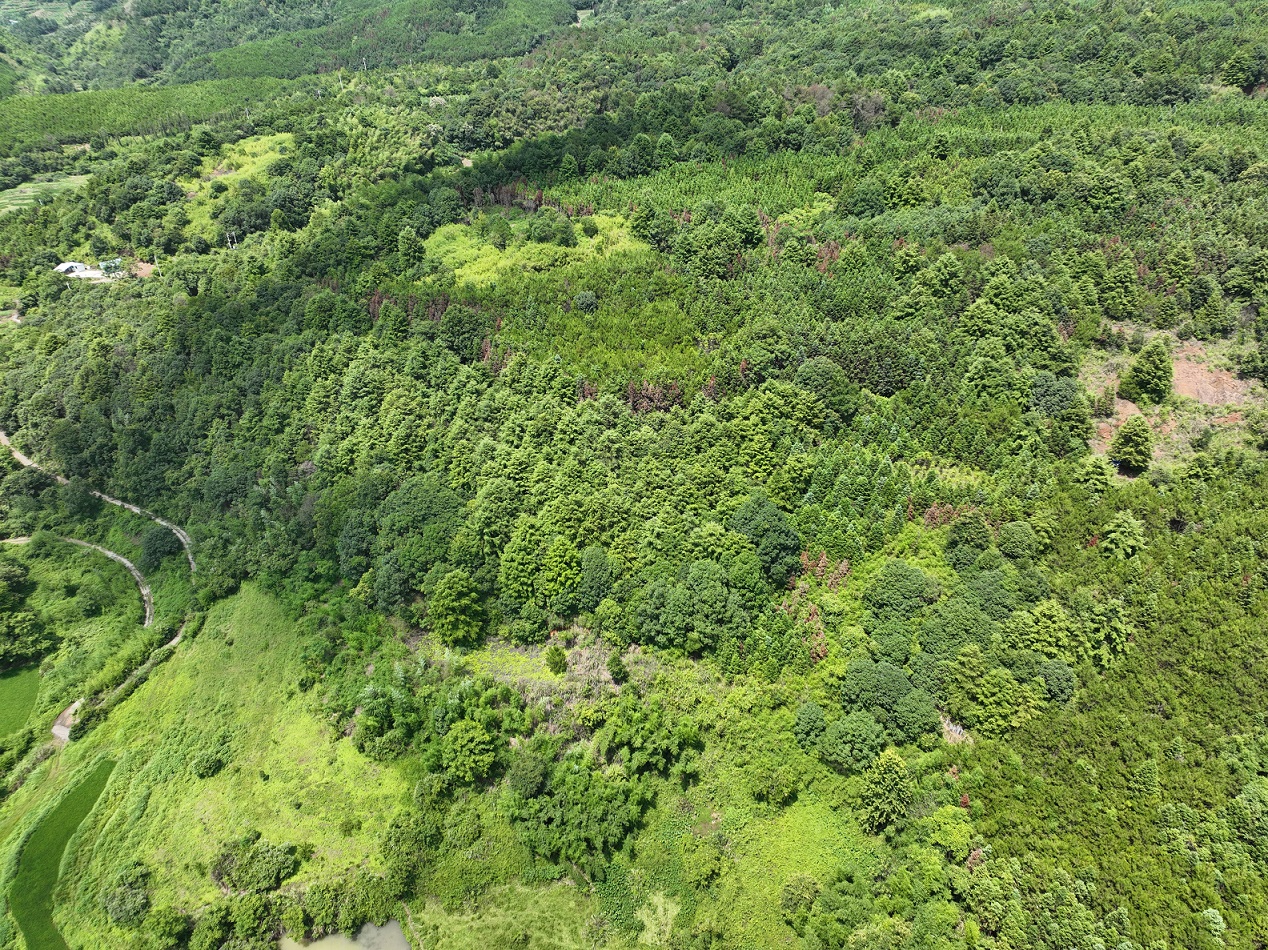

Chinese Journal of Plant Ecology >
Community types and characteristics of Keteleeria pubescens forests in China
Received date: 2024-10-06
Accepted date: 2024-12-24
Online published: 2024-12-25
Supported by
Special Foundation for National Science and Technology Basic Resources Investigation of China(2019FY202300)
Keteleeria pubescens is endemic to China and is classified as a national second-class key protected wild plant species. The distribution areas of the K. pubescens communities were extremely narrow, primarily occurred in patches in mountainous and hilly regions of Guizhou and Hunan. To reveal the spatial distribution, community composition, and characteristics of K. pubescens forests, a comprehensive plot surveys of the communities from 2021 to 2023 during the plant growing season. A total of 4 survey sites were selected within the distribution range of K. pubescens forests, with 11 plots established, largely covered all distribution areas of the forests. Information on habitat, species composition, and quantity characteristics of all the forests were recorded. The main results of the quantitative analysis are: (1) K. pubescens forests had a rich species composition, with a total of 102 vascular plant species recorded; (2) Totally classified into 2 Association Groups and 2 Associations, namely, K. pubescens + Evergreen Broadleaf Tree Association Group and K. pubescens - Herb Association Group; K. pubescens + Quercus glauca Association and K. pubescens - Woodwardia japonica Association; (3) The forests’ vertical stratification is obvious, including tree, shrub and herb layers, in the tree layer there were mainly K. pubescens and species of Quercus, Castanopsis, and Pinus; (4) The regeneration of K. pubescens is poor. This study surely provides solid scientific data for effective conservation and management of K. pubescens forests.

HAN Peng-Bin , HE Bin , LU Shu-Gang , TANG Cindy Q. . Community types and characteristics of Keteleeria pubescens forests in China[J]. Chinese Journal of Plant Ecology, 2025 , 49(6) : 825 -832 . DOI: 10.17521/cjpe.2024.0345
| [1] | Fu LG, Li N, Robert R (1999). Keteleeria//Wu ZY, Raven PH, Hong DY. Flora of China: Vol. 4. Science Press, Beijing. |
| [2] | ISCREP(Information System of Chinese Rare and Endangered Plants) (2021). [2024-03-12] https://www.iplant.cn/rep/protlist . |
| [3] | Li DL, Yang Y, Yang S, Chen YK (2019). The complete chloroplast genome sequence of Keteleeria hainanensis (Pinaceae). Mitochondrial DNA. Part B: Resources, 4, 2934-2935. |
| [4] | Ma CC, Li YY, Wang HZ, Fan RR, Li M, Yan JP, Zhu Y, Duan YF (2022). Geographical distribution and the prediction of the potential distribution of Keteleeria. Journal of Northwest Forestry University, 37(4), 158-165. |
| [麻璨璨, 李媛媛, 王海珍, 范蓉蓉, 李蒙, 严继萍, 朱跃, 段一凡 (2022). 油杉属植物的地理分布及潜在分布区预测. 西北林学院学报, 37(4), 158-165.] | |
| [5] | Tichy L (2002). JUICE, software for vegetation classification. Journal of Vegetation Science, 13, 451-453. |
| [6] | Wang CY, Ma SB, Lü J, Dang CL (2012). Ecological and geographical distribution of Keteleeria and its systematic evolution in China. Guihaia, 32, 612-616. |
| [王崇云, 马绍宾, 吕军, 党承林 (2012). 中国油杉属植物的生态地理分布与系统演化. 广西植物, 32, 612-616.] | |
| [7] | Wang GH, Fang JY, Guo K, Xie ZQ, Tang ZY, Shen ZH, Wang RQ, Wang XP, Wang DL, Qiang S, Yu D, Peng SL, Da LJ, Liu Q, Liang CZ (2020). Contents and protocols for the classification and description of Vegetation Formations, Alliances and Associations of vegetation of China. Chinese Journal of Plant Ecology, 44, 128-178. |
| [王国宏, 方精云, 郭柯, 谢宗强, 唐志尧, 沈泽昊, 王仁卿, 王襄平, 王德利, 强胜, 于丹, 彭少麟, 达良俊, 刘庆, 梁存柱 (2020). 《中国植被志》编研内容与规范. 植物生态学报, 44, 128-178.] | |
| [8] | Wang GH, Guo K, Xie ZQ, Tang ZY, Tang ZY, Jiang YL, Fang JY (2022). Interpretations, supplements, and modifications of some protocols for compiling Vegegraphy of China. Chinese Journal of Plant Ecology, 46, 368-372. |
| [王国宏, 郭柯, 谢宗强, 唐志尧, 蒋延玲, 方精云 (2022). 《中国植被志》研编规范的若干说明、补充与修订. 植物生态学报, 46, 368-372.] | |
| [9] | Wu JR (1982). Endemic and precious tree species of China—Keteleeria pubescens. Hunan Forestry Science & Technology, 9(3), 17-23. |
| [伍家荣 (1982). 我国特有珍贵树种——柔毛油杉. 湖南林业科技, 9(3), 17-23.] | |
| [10] | Wu ZY (1991). The areal-types of Chinese genera of seed plants. Plant Diversity, 13, 1-3. |
| [吴征镒 (1991). 中国种子植物属的分布区类型. 植物多样性, 13, 1-3.] | |
| [11] | Wu ZY (2003). Revision of “The areal types of the world families of seed plants”. Acta Botanica Yunnanica, 25, 535-538. |
| [吴征镒 (2003). 《世界种子植物科的分布区类型系统》的修订. 云南植物研究, 25, 535-538.] | |
| [12] | Zhang HD (1980). The origin and development of the cathaysian flora. Acta Scifntiarum Naturalium Universitatis Sunyaatseni, 19(1), 89-98. |
| [张宏达 (1980). 华夏植物区系的起源与发展. 中山大学学报(自然科学版), 19(1), 89-98.] | |
| [13] | Zuo JB (1989). Fuzzy analysis of the relationship between the distribution pattern of Taxodium and floristic zoning in China. Journal of Central South Forestry University, 9, 199-205. |
| [左家哺 (1989). 中国油杉属分布型与植物区系分区关系的模糊分析. 中南林学院学报, 9, 199-205.] |
/
| 〈 |
|
〉 |